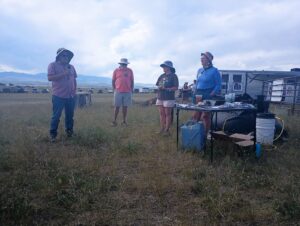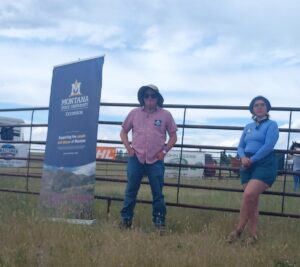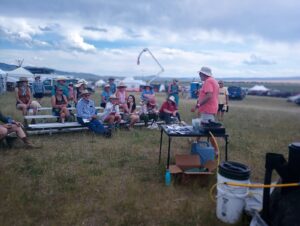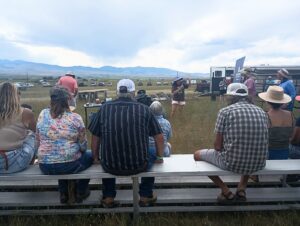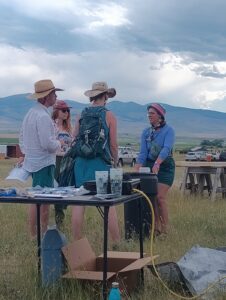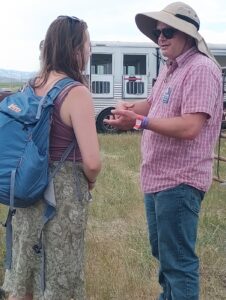Final report for WRGR21-006
Project Information
Anaerobic digestion (AD) of organic residues is a globally expanding sustainable technology. In the US, commercial AD systems are increasingly used on large dairy and hog farms for generating biogas from manure. These high-tech systems are neither affordable nor technically viable for smaller farms, including diversified grain, horticultural, and mixed farms. In contrast, small AD systems have the potential to help small farmers become energy-resilient and decrease their greenhouse gas emissions as demonstrated by two SARE projects in Washington and Florida. Furthermore, most large-scale AD systems do not make use of biofertilizers which can be obtained from the digestate and applied as organic fertilizers to increase the soil microflora and organic matter content. Biofertilizers can also be sold to diversify a farm’s portfolio. The goal of the present project by researchers, extension agents, and collaborating farmers in Montana is to build on the experience gained in Washington and Florida and to disseminate this sustainable technology in the Western US, as most small farmers in the region are not familiar with AD. We will facilitate professional development and create an open dialog on AD using a participatory farmer-to-farmer approach, enriched by technological information provided by participating farmers, extension agents, and researchers. We will develop three instructional videos where a farmer experienced in using AD explains the technology first-hand on his farm. The videos will cover digester types, the installation and operation of digesters, the right feedstock choices, and the usability of biogas and biofertilizers. In addition, we will generate hands-on online manuals for the use of AD on small farms. We will also conduct a webinar for extension agents and agricultural educators. Finally, we will organize two field demonstrations on biofertilizers, where local producers and extension agents will exchange information about how to use AD systems and biofertilizers.
Overall Objective: Generate professional development activities that will increase the energetic resilience of small farms in the Western region and decrease their greenhouse gas emissions by introducing ag educators, agricultural professional, and farmers to the operation of inexpensive and reliable small-scale anaerobic digesters as well as to possible uses of their core products, biogas and biofertilizers.
Specific Objective 1 (O1): Inform ag educators, agricultural professionals, and farmers in the Western region on the installation, functionality, and operation of small-scale anaerobic digesters for processing agricultural residues as well as on the usability of products generated by anaerobic digestion.
Specific Objective 2 (O2): Highlight the potential of producing biofertilizers using small-scale anaerobic digesters to diversify the product portfolio of small farms in the Western region and to increase their soil health by applying these biofertilizers to their crops.
Anaerobic digestion (AD) of organic residues is a globally expanding sustainable technology for generating biogas with a high methane content [1]. In the US, the number of municipal AD plants has almost doubled since 2010, and currently, over 8,000 large dairy and hog farms use AD to produce biogas from their manure, generating renewable energy [2].
Small-scale, low-tech AD systems for processing food and agricultural waste, often applied at the household scale and frequently using co-digestion of plant and animal residues, are becoming increasingly common in Asia [3-5], Africa [6], and Latin America [7, 8]. In contrast, commercial AD technologies used in most US farms are designed for large-scale livestock operations. Thus, the adaptation of low-tech AD technologies in the US would benefit small farms by making them economically resilient to volatile energy prices, while contributing to reducing their net methane emissions [9] and enhancing their soil nutrient management. For example, large-scale AD systems commonly do not use the digestate as biofertilizer. Biofertilizers are fermented animal and plant residues with elevated micro-nutrient content. They enhance the soil microflora and increase the soil organic matter content [8, 10]. Apart from using biofertilizers for their crops, there are also reports of small farms successfully selling this product.
A Western SARE on-farm biogas technology project completed by Washington State University demonstrated that AD is a technically and economically viable option for smaller farms. It involved the development of three easy-to-operate AD units at small farms in Washington which served as effective biogas reactors [9]. Also, a Southern SARE project in Florida focused on AD biofertilizer production on small farms. This effort emphasized the analysis of feedstock on small farms and the design of a biodigester [11]. Both SARE projects (Table 1) generated first-hand experience on the usability, benefits, and limitations of AD.
At Montana State University (MSU), members of the project team are currently collaborating with extension specialists in an EPA-funded project dedicated to the use of small-scale biodigesters for processing household food waste [12].
The present project by MSU researchers and collaborating farmers and extension agents builds on the experience gained in Washington and Florida and aims at generating professional development activities to enhance the proper adoption of AD technologies. We will develop a series of instructional videos where an experienced Montana farmer facilitates small-scale, on-farm AD solutions for farms in the Western region. We will generate a manual and organize a webinar for extension agents across the Western region. We will also conduct field demonstrations to facilitate the use of AD digestate as a biofertilizer, combining the results of the previously funded SARE project with experience from our EPA project. We expect that the successful implementation of our project will benefit from the currently favorable interest regarding AD [12] and enhance the environmental, social, and economic sustainability of small-scale farms. We do not expect natural or regulative limitations for generating and distributing our outreach material.
Cooperators
- (Researcher)
- (Educator)
- - Producer
- (Educator)
- (Educator)
- (Educator)
- - Producer
- (Educator)
- (Researcher)
Education & Outreach Initiatives
To inform our audience about the appropriate use of biofertilizers for agricultural production and the functioning of a small digester unit, we held a field demonstration at the MSU horticultural farm, inviting local producers, gardeners, MSU extension agents, faculty, and students, as well as interested residents.
The field day consisted of a demonstration of a Home Biogas biodigester, the use of biofertilizer for crop fertilization, and a demonstration plot of diverse plants fertilized using biofertilizer. This was followed by a Q&A round and an experiential section where attendees could practice. The event concluded with a tour through the MSU Hort Farm and a gathering event with snacks.
- We gained material for our outreach videos.
- Two attendees decided to experiment with biofertilizers on their farms/gardens. They are currently using this technology and we will follow up on their experiences and provide expertise beyond the project span.
- One MSU student decided to include biofertilizers in their MS project.
- Numerous local residents and local media reached out to us and aimed to learn more about AD.
Educational & Outreach Activities
Demonstration of AD unit for Small Gardener Association in Helena, MT
Demonstration of AD unit at Red Ants Pants Musci Festival (for MSU Extension)
Participation Summary:
Preliminary activities for project outputs (videos, manual, field day).
Creation of an extensive library of publications on anaerobic digestion (AD) on small farms (baseline for videos and manual), COMPLETE
Systematic literature review and indexing of respective publications, COMPLETE
Development of video scripts, COMPLETE
Assignment of area for field demonstration & preliminary area preparation, COMPLETE
Training of one undergraduate research assistant on AD and conducting a literature review, COMPLETE
Online meetings with farmers (2 meetings) and filmmaker (1). COMPLETE
Correspondence (email, phone) with agency and extension collaborators. COMPLETE
Farmer and advisor feedback COMPLETE
Outreach video cutting and compilation COMPLETE
Outreach video dissemination COMPLETE
Processing of systematic literature review findings in NVivo COMPLETE
Draft manual COMPLETE
Draft figures COMPLETE
External (experts, producers) review of draft manual COMPLETE
Manual PUBLISHED
Manual dissemination COMPLETE (online and print)
Learning Outcomes
Project Outcomes
The outcomes of this project are expected to be primarily triggered by our outreach materials (videos, manual). The videos were released in November 2022 and the manual is still about to be completed. In both cases, it is, therefore, too early to assess specific learning and action outcomes at this point. What we do know is that our videos have been watched +500 times and that our work on anaerobic digestion has attracted the interest of several community members across the Western region who have contacted us via email and phone. Our work was also covered in at least five local newspapers of the region, for example, the Bozeman Daily Chronicle. Finally, we were contacted by two companies in this field who are interested in further collaboration. We are positive that, by the end of the project, we will be able to report more specifically on the outcomes generated by our outreach materials. Similar to the outreach material, our field day has generated a lot of interest among Montana producers and extension and research faculty at Montana State University. For example, a PhD student decided to work on anaerobic digestion in her doctoral project.
- Contacted by +20 national and international researchers/activists/students interested in this project
- 2 individuals decided to use technology on their farm/garden and received guidance
- Total +1200 clicks on our online videos (August 2023)
Climate (long winters) is the most limiting factor for small AD solutions, while large digesters represent considerable financial investments for farmers. We recommend future projects with a focus on logistics/organization for centralized local digesters (for 5-15 farms).
Small AD technology is specifically appealing to small horticultural producers, including those in peri-urban settings. They are more interested in using the digestate as fertilizer. In change, large digesters are more appropriate for larger producers generating a consistent and constant feedstock, such as dairy farms. These users are focused on using the biogas.
Smaller digesters may be used to process farm and household food waste simultaneously. Synergies with municipal waste management are possible.
While our videos have reached a large audience, most impact was generated by our field day.
Students across disciplines are excited about learning more about AD technology.
